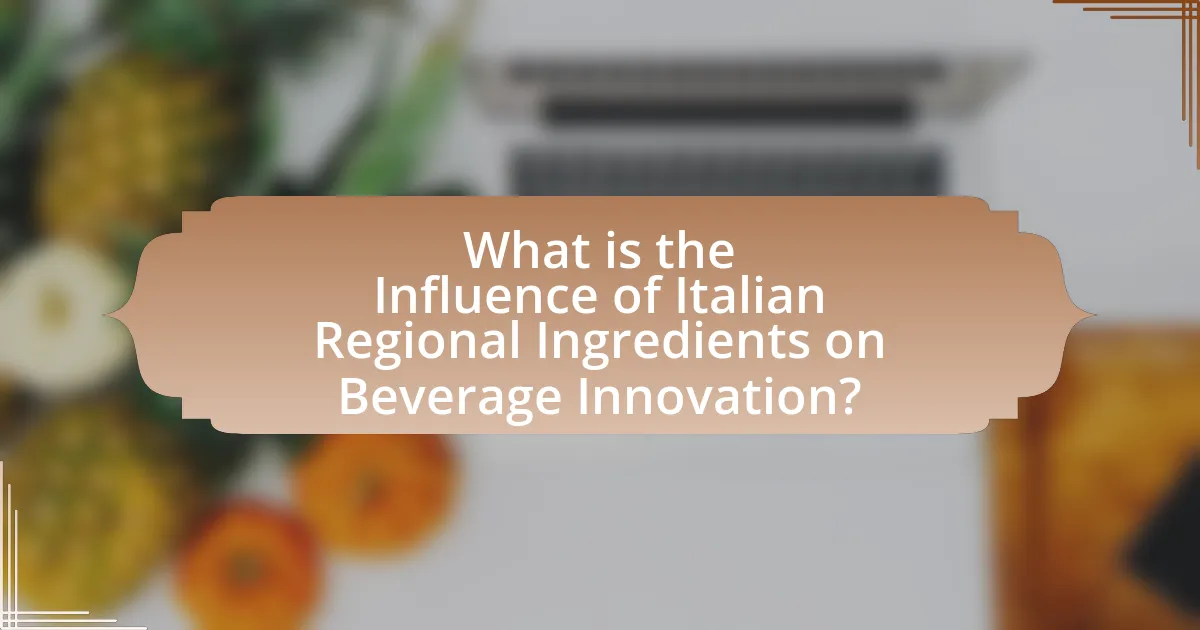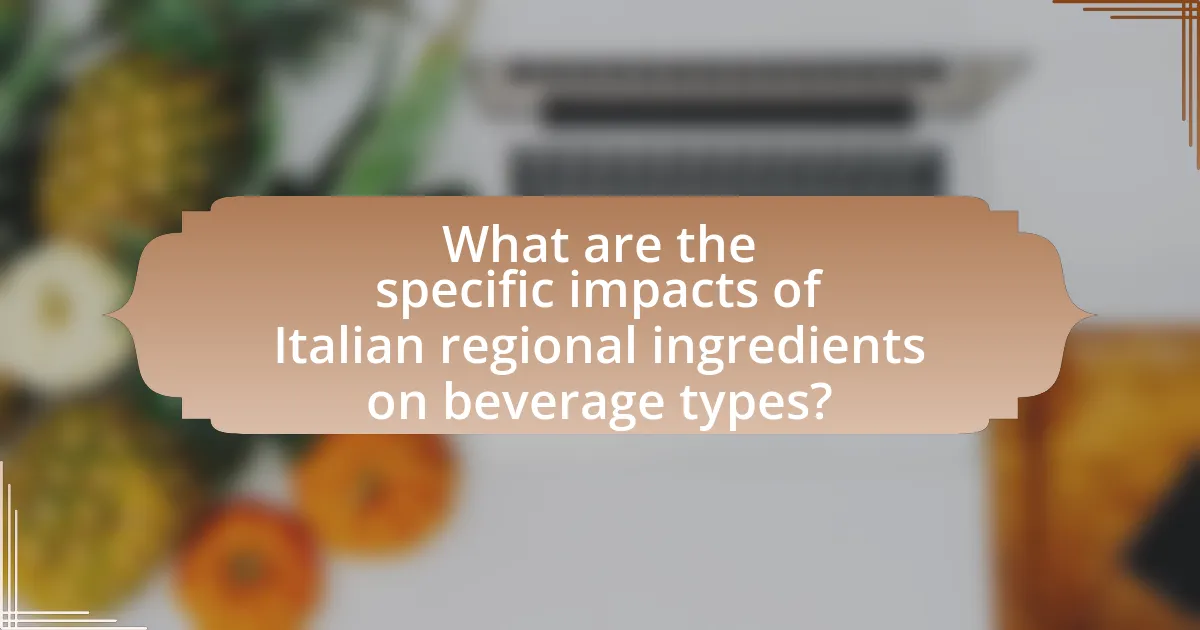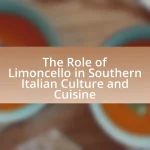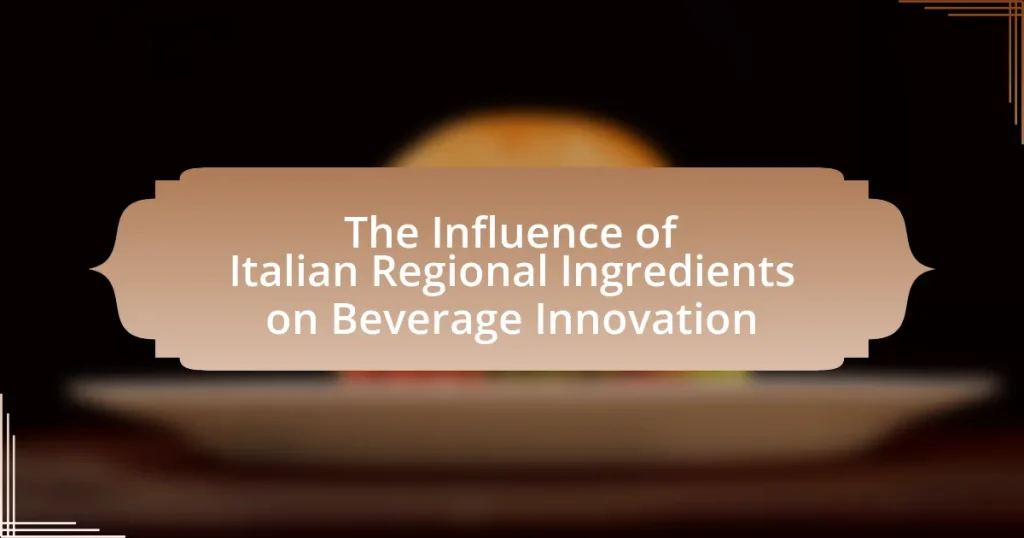The article examines the significant influence of Italian regional ingredients on beverage innovation, highlighting how unique flavors, traditional practices, and local authenticity shape drink trends. It discusses key ingredients such as Sicilian lemons, Tuscan olive oil, and various herbs that enhance flavor profiles and reflect local culture. The piece emphasizes the importance of these ingredients in creating innovative beverages that resonate with consumers seeking authenticity, as well as their role in driving marketability and consumer interest. Additionally, it explores how understanding these ingredients can lead to new beverage creations and the impact of regional sourcing on sustainability and local economies.

What is the Influence of Italian Regional Ingredients on Beverage Innovation?
Italian regional ingredients significantly influence beverage innovation by introducing unique flavors, traditional practices, and local authenticity. For instance, the use of Sicilian lemons in cocktails enhances freshness and acidity, while the incorporation of Tuscan olive oil in drinks adds a distinct richness. These ingredients not only reflect the diverse culinary heritage of Italy but also inspire mixologists to create innovative beverages that resonate with consumers seeking authentic experiences. Research indicates that beverages utilizing local ingredients can increase consumer interest and marketability, as seen in the rise of craft cocktails that highlight regional flavors.
How do Italian regional ingredients shape beverage trends?
Italian regional ingredients significantly shape beverage trends by introducing unique flavors and traditional practices that reflect local culture and agriculture. For instance, the use of Sicilian citrus fruits in cocktails has led to a rise in refreshing, aromatic drinks that highlight the region’s agricultural heritage. Additionally, the incorporation of herbs like basil from Campania or juniper from the Alps has influenced the craft cocktail movement, promoting the use of fresh, locally sourced components. This trend is supported by the increasing consumer preference for authenticity and sustainability in beverages, as evidenced by a 2022 report from the Italian Institute of Statistics, which noted a 30% increase in the demand for locally sourced ingredients in the beverage sector.
What are the key regional ingredients used in Italian beverages?
Key regional ingredients used in Italian beverages include grapes, citrus fruits, herbs, and grains. Grapes are essential for producing wines, with regions like Tuscany known for Sangiovese and Piedmont for Barolo. Citrus fruits, particularly lemons from the Amalfi Coast, are crucial for beverages like Limoncello. Herbs such as basil and rosemary are often infused in cocktails and aperitifs, while grains like barley are used in beer production, especially in northern Italy. These ingredients reflect the diverse agricultural practices across Italy’s regions, contributing to the unique flavors and characteristics of Italian beverages.
How do these ingredients reflect local culture and traditions?
Italian regional ingredients reflect local culture and traditions by embodying the unique agricultural practices, historical influences, and culinary heritage of each region. For instance, the use of locally sourced olives in southern Italy highlights the Mediterranean diet’s emphasis on healthy fats and the importance of olive oil in traditional cooking. Additionally, the incorporation of indigenous herbs like basil in pesto from Liguria showcases the region’s agricultural bounty and its historical trade routes that influenced flavor profiles. These ingredients not only serve as staples in local cuisine but also tell stories of the land, climate, and cultural practices that have shaped the identity of each region over centuries.
Why is the study of Italian regional ingredients important for beverage innovation?
The study of Italian regional ingredients is crucial for beverage innovation because it fosters unique flavor profiles and enhances authenticity in drink creation. Italian regions offer a diverse array of ingredients, such as local herbs, fruits, and spices, which contribute to distinctive tastes that can differentiate beverages in a competitive market. For instance, the use of Sicilian lemons or Tuscan olive oil can elevate a cocktail or a non-alcoholic drink, making it more appealing to consumers seeking novel experiences. Additionally, understanding these regional ingredients allows beverage creators to tap into cultural narratives and traditions, enriching the storytelling aspect of their products. This connection to heritage not only attracts consumers but also supports local agriculture and economies, reinforcing the importance of regional sourcing in beverage innovation.
What role do regional ingredients play in flavor profiles?
Regional ingredients are crucial in shaping flavor profiles by providing unique tastes and aromas that reflect local terroir and culinary traditions. For instance, Italian regional ingredients like San Marzano tomatoes from Campania or Pecorino cheese from Tuscany contribute distinct flavors that enhance the authenticity and complexity of beverages. These ingredients not only influence the sensory experience but also connect consumers to the cultural heritage of the region, as evidenced by the increasing popularity of craft cocktails that incorporate local herbs and fruits, showcasing the diversity of Italian agriculture.
How can understanding these ingredients lead to new beverage creations?
Understanding Italian regional ingredients can lead to new beverage creations by enabling innovators to blend traditional flavors with modern techniques. For instance, the use of unique herbs like basil from Campania or citrus fruits from Sicily can inspire the development of cocktails that highlight these distinct tastes. Research indicates that beverages incorporating local ingredients often resonate more with consumers, as they evoke a sense of place and authenticity. This connection can enhance marketability and consumer interest, driving innovation in beverage formulation.

What are the specific impacts of Italian regional ingredients on beverage types?
Italian regional ingredients significantly influence beverage types by enhancing flavor profiles, promoting local traditions, and fostering innovation. For example, the use of Sicilian lemons in limoncello creates a distinct citrus flavor that is emblematic of the region’s agricultural heritage. Similarly, the incorporation of Tuscan olive oil in cocktails adds a unique richness and depth, reflecting the local culinary practices. Additionally, the use of indigenous grape varieties, such as Nebbiolo in Barolo wine, showcases the terroir and biodiversity of Italian regions, leading to beverages that are not only unique but also representative of their origins. This regional specificity in ingredients drives both consumer interest and market differentiation, as beverages become a reflection of local culture and identity.
How do regional ingredients influence wine production in Italy?
Regional ingredients significantly influence wine production in Italy by determining the flavor profiles, aromas, and overall characteristics of the wines. Each Italian region boasts unique climatic conditions, soil types, and indigenous grape varieties, which collectively shape the wine’s identity. For instance, the volcanic soils of Etna in Sicily contribute to the distinct minerality of wines produced there, while the cooler climate of Northern Italy allows for the cultivation of grapes like Pinot Grigio, resulting in crisp and refreshing whites. Additionally, traditional practices and local regulations, such as those found in the Denominazione di Origine Controllata (DOC) system, further ensure that regional ingredients are utilized effectively, preserving the authenticity and heritage of Italian wines.
What unique characteristics do these ingredients bring to Italian wines?
Italian wines are distinguished by their unique characteristics derived from regional ingredients, including indigenous grape varieties, local terroir, and traditional winemaking techniques. Indigenous grape varieties, such as Sangiovese and Nebbiolo, contribute specific flavor profiles and aromas that reflect the local climate and soil conditions. The terroir, which encompasses the geographical and environmental factors of a region, imparts distinct mineral qualities and acidity levels to the wines, enhancing their complexity. Traditional winemaking techniques, often passed down through generations, further influence the texture and aging potential of the wines, resulting in a diverse range of styles that are emblematic of Italy’s rich viticultural heritage.
How do terroir and local practices affect wine innovation?
Terroir and local practices significantly influence wine innovation by shaping the unique characteristics of grapes and the methods used in winemaking. Terroir, which encompasses the soil, climate, and topography of a region, directly affects grape quality and flavor profiles, leading to distinct wine styles that reflect their origin. For instance, the volcanic soils of Etna in Sicily produce wines with unique minerality, prompting winemakers to experiment with indigenous grape varieties and innovative techniques. Local practices, such as traditional fermentation methods or sustainable farming, further drive innovation by encouraging the adaptation of new technologies and approaches that enhance quality and sustainability. This interplay between terroir and local practices fosters a dynamic environment for wine innovation, as evidenced by the rise of natural wines in regions like Tuscany, where winemakers prioritize minimal intervention and express the terroir’s authenticity.
What is the role of Italian herbs and spices in cocktail innovation?
Italian herbs and spices play a crucial role in cocktail innovation by enhancing flavor profiles and introducing unique aromatic qualities. Ingredients such as basil, rosemary, and oregano are increasingly used in mixology to create complex and refreshing drinks that reflect Italian culinary traditions. For instance, the use of basil in cocktails like the Basil Gimlet adds a fresh, herbal note that complements citrus flavors, while rosemary can impart a savory depth to gin-based drinks. This trend is supported by the growing popularity of Italian-inspired cocktails in bars and restaurants, showcasing how these ingredients can elevate the drinking experience and attract consumers seeking novel flavors.
Which herbs and spices are most commonly used in Italian cocktails?
The most commonly used herbs and spices in Italian cocktails include basil, rosemary, mint, and thyme. These ingredients are integral to Italian mixology, enhancing flavors and aromas in various drinks. For example, basil is often used in cocktails like the Basil Smash, while rosemary can be found in drinks such as the Rosemary Gin Fizz. Mint is a key component in refreshing cocktails like the Mojito, which has Italian variations. Thyme adds a unique earthy note to cocktails, making it a popular choice in craft mixology. The use of these herbs and spices reflects Italy’s rich culinary tradition and regional ingredient influence on beverage innovation.
How do these ingredients enhance the sensory experience of cocktails?
Italian regional ingredients enhance the sensory experience of cocktails by introducing unique flavors, aromas, and textures that reflect the local terroir. For instance, ingredients like fresh herbs, citrus fruits, and artisanal spirits contribute distinct taste profiles that elevate the overall drinking experience. The use of high-quality, locally sourced components, such as Sicilian lemons or Tuscan olive oil, not only adds authenticity but also engages multiple senses, from the vibrant aroma of herbs to the visual appeal of garnishes. Studies have shown that sensory attributes significantly influence consumer preferences, with specific ingredients enhancing the perceived quality and enjoyment of cocktails.

How do Italian regional ingredients inspire global beverage trends?
Italian regional ingredients inspire global beverage trends by introducing unique flavors and traditional practices that enhance the diversity of drink offerings worldwide. For instance, the use of local botanicals in Italian aperitifs, such as vermouth and amaro, has led to a resurgence in craft cocktails globally, where bartenders incorporate these complex flavors into their creations. Additionally, the popularity of Italian wines, particularly Prosecco and Chianti, has influenced sparkling wine production and wine pairings in various countries, promoting a trend towards lighter, more effervescent beverages. The emphasis on quality and authenticity in Italian regional ingredients encourages a focus on artisanal production methods, which has been adopted by beverage makers around the world, leading to a broader appreciation for locally sourced and sustainably produced drinks.
What are some examples of Italian-inspired beverages outside of Italy?
Examples of Italian-inspired beverages outside of Italy include Negroni, Aperol Spritz, and Italian sodas. The Negroni, originally from Florence, has gained popularity in bars worldwide, often made with gin, vermouth, and Campari. The Aperol Spritz, a refreshing cocktail made with Aperol, prosecco, and soda water, is widely enjoyed in various countries, especially during summer. Italian sodas, which combine flavored syrups with carbonated water, have also become a staple in cafes across the globe, showcasing the influence of Italian flavors in beverage innovation.
How have Italian ingredients been adapted in international markets?
Italian ingredients have been adapted in international markets by incorporating them into local cuisines and beverage formulations, often leading to innovative products that blend traditional flavors with regional preferences. For instance, the use of Italian herbs like basil and oregano has become common in various global dishes, while Italian wines and spirits, such as Prosecco and Amaretto, have been integrated into cocktails worldwide. This adaptation is evidenced by the rise of Italian-inspired beverages, such as the Aperol Spritz, which has gained popularity in bars across the United States and Europe, showcasing how Italian flavors can be successfully merged with local tastes.
What trends are emerging from the fusion of Italian ingredients with local flavors?
Emerging trends from the fusion of Italian ingredients with local flavors include the incorporation of traditional Italian herbs and spices into regional beverages, creating unique flavor profiles that reflect local cultures. For instance, the use of Italian basil in cocktails has gained popularity, enhancing drinks with a fresh, aromatic quality that resonates with local tastes. Additionally, Italian wines are increasingly blended with indigenous grape varieties, resulting in innovative wines that maintain the essence of both Italian and local terroirs. This trend is supported by the growing consumer interest in craft beverages that emphasize authenticity and regional identity, as evidenced by a 2022 report from the Beverage Marketing Corporation highlighting a 15% increase in sales of locally inspired craft drinks.
What best practices can beverage innovators adopt from Italian regional ingredients?
Beverage innovators can adopt the best practice of utilizing locally sourced, high-quality Italian regional ingredients to enhance flavor profiles and authenticity. For instance, using ingredients like Sicilian lemons or Tuscan olives can create unique beverages that reflect the terroir and cultural heritage of Italy. This approach not only appeals to consumers seeking authentic experiences but also supports local agriculture and sustainability. Research indicates that products made with regional ingredients often command higher prices and consumer loyalty, as seen in the success of Italian craft spirits and wines that emphasize local sourcing.
How can producers effectively source and utilize regional ingredients?
Producers can effectively source and utilize regional ingredients by establishing strong relationships with local farmers and suppliers, ensuring access to fresh, high-quality products. This approach allows producers to incorporate unique flavors and characteristics of regional ingredients into their beverages, enhancing authenticity and appeal. For instance, utilizing ingredients like Sangiovese grapes from Tuscany or lemons from the Amalfi Coast not only supports local agriculture but also aligns with consumer preferences for locally-sourced and sustainable products. Research indicates that beverages made with regional ingredients can increase marketability, as consumers are increasingly drawn to products that reflect local culture and heritage.
What strategies can be employed to highlight these ingredients in marketing?
To highlight Italian regional ingredients in marketing, brands can employ storytelling that emphasizes the origin and cultural significance of these ingredients. This strategy connects consumers emotionally to the product, enhancing perceived value. For instance, showcasing the unique terroir of a specific region, such as the volcanic soil of Mount Etna for wines, can attract consumers interested in authenticity and quality. Additionally, utilizing visual content, such as high-quality images and videos of the ingredients being sourced or prepared, can create a compelling narrative that engages potential customers. Research indicates that consumers are increasingly drawn to products with a strong story, as evidenced by a study from the Food Marketing Institute, which found that 70% of shoppers are influenced by the story behind a product.










